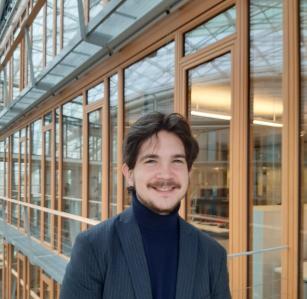Ostrava ist eine Stadt mit pragmatischen Menschen, die auch für ihre Geradlinigkeit und Entschlossenheit bekannt sind. Jan Žemla, Intendant des Philharmonischen Orchesters von Ostrava, war bei seiner Ankunft in der Stadt von dieser sachlichen Herangehensweise fasziniert. Er glaubt fest an die transformative Kraft der Musik und ließ sich von diesem Geist zu einem neuen Projekt inspirieren – einem Projekt, das das kulturelle Feuer Ostravas neu entfacht.

Janáček Philharmonic Orchestra
Alles begann, als Žemla den Probenort des Orchesters zum ersten Mal sah: das Haus der Kultur, ein Gebäude aus den frühen 1960er-Jahren. „Das Gebäude befand sich in einem schlechten Zustand und musste saniert werden“, erinnert sich Žemla. „Viele technische Probleme, etwa bei der Strom- und Wasserversorgung, erschwerten uns das Proben. Außerdem war die Akustik für ein Orchester denkbar schlecht.“
Žemla erkannte schnell, dass das Janáček-Orchester ein neues Zuhause brauchte, und warb bei den lokalen Behörden um Unterstützung. So wurde der Plan gefasst, das Haus der Kultur zu sanieren und es um einen Konzertsaal zu erweitern. Der neue Konzertsaal wird moderne Akustik mit Denkmalschutz vereinen und 1 300 Sitzplätze für kulturelle und pädagogische Veranstaltungen bieten.
„Unser Ziel ist es, etwas zu schaffen, das nicht nur der Gemeinschaft dient, sondern auch Ostrava auf die kulturelle Landkarte Europas setzt“, sagt Žemla.
Die EIB fördert das Projekt mit einem Kredit über zwei Milliarden tschechische Kronen (84 Millionen Euro) an die Stadt Ostrava, der im Juli 2024 unterzeichnet wurde. Die Mittel sollen der Stadt den Weg hin zu einer lebendigen, modernen Metropole mit einem blühenden Kultursektor ebnen.
- Erfahren Sie, wie neue Güterzüge in Tschechien Jobs schaffen, abgelegene Regionen besser anbinden und Emissionen senken
Ein neues Zuhause
Das Janáček-Orchester ist eines der renommiertesten Symphonieorchester in Tschechien. Es ist nach dem berühmten Komponisten Leoš Janáček benannt, der in einem Dorf in der Nähe von Ostrava geboren ist. Zu seinen Dirigenten und Komponisten zählen Größen wie Igor Strawinsky, Sergei Prokofjew und Paul Hindemith. Auch heute noch sind die Menschen in der Region stolz auf das Orchester.
Als Žemla und die lokalen Behörden nach Entwürfen für die Konzerthalle suchten, war es ihnen wichtig, dass der Neubau den Geist und die Bedeutung des Orchesters für die Stadt sichtbar macht. Ein Vorschlag dazu kam von Steven Holl, einem Weltklasse-Architekten, der für seine tiefe Liebe zur Musik bekannt ist.
„Steven hatte die Idee, dass das Orchester das Instrument und der Konzertsaal das Etui dafür ist“, sagt er. „So wie ein Etui ein zerbrechliches und empfindliches Instrument schützt, wird das Gebäude das Orchester schützen.“

Der Entwurf des Konzertsaals ist der bauchigen Form eines Musikinstrumentenkoffers nachempfunden. Holl hat sich dabei von Musik und Architektur inspirieren lassen. Auch das innovative Interieur mit perforierten Holzpaneelen und Beleuchtung schafft einen Raum, der perfekt für Musik passt.
Neben seiner Hauptfunktion als Konzertsaal wird das Gebäude auch als wandlungsfähiger Theatersaal dienen und eine Vielzahl kultureller und pädagogischer Veranstaltungen beherbergen. „Es wird Theatersäle, Bildungszentren und Räume für gesellschaftliche Veranstaltungen geben, die dafür sorgen, dass den ganzen Tag über Leben im Gebäude ist, nicht nur während der Konzerte“, sagt Žemla.
Unterstützung einer Übergangsregion
Es ist nicht leicht, einen modernen Konzertsaal zu bauen und gleichzeitig ein riesiges Haus der Kultur aus den 1960er-Jahren zu sanieren. Das erfordert erhebliche Finanzmittel, eine sorgfältige Planung und viel Zeit.
Die EIB unterstützt das ehrgeizige Projekt mit einer umfangreichen Finanzierung, die die Stadtentwicklung und den Zusammenhalt in der Region fördert. Daneben erhält das Vorhaben einen Zuschuss von 500 Millionen tschechischen Kronen (21 Millionen Euro) aus der EU-Darlehensfazilität für den öffentlichen Sektor, die zum Mechanismus für einen gerechten Übergang gehört, und weitere Mittel aus städtischen, regionalen und nationalen Quellen.
„Dies ist ein Leuchtturmprojekt in Tschechien, das als Modell für ähnliche Projekte im ganzen Land dienen kann“, erklärt Peter Chovan, ein Kreditreferent der EIB, der an dem Projekt beteiligt war.
Für die Stadt Ostrava ist dies eine gute Gelegenheit, die erforderlichen Mittel für den Bau eines Konzertsaals zu beschaffen, von dem die Stadt seit 150 Jahren träumt.
- Erfahren Sie mehr darüber, wie finnische Lehrerinnen und Lehrer auf zeitgemäße Schulen setzen und was andere Länder davon lernen können
Ein neuer Herzschlag im Zentrum Tschechiens
Ostrava war wegen seinem reichen Industrie- und Bergbauerbe einst als „schwarzes Herz“ Tschechiens bekannt. Als die Bergwerke in den 1990er-Jahren geschlossen wurden, tat sich die Stadt schwer, eine neue Identität zu finden. „Es geht nicht nur darum, eine Konzerthalle zu bauen“, sagt Kamil Dörfler, Stadtentwicklungsexperte der EIB, der eng in die Entwicklung des Projekts eingebunden war. „Es geht darum, Ostrava eine neue Richtung zu geben, die das kulturelle Erbe der Stadt einbezieht und gleichzeitig in die Zukunft blickt.“

Artchitechtuul
Ein solcher Wandel wird oft als „Bilbao-Effekt“ bezeichnet, bei dem ein einzelnes herausragendes Gebäude die Stadterneuerung katalysieren und das Image einer Stadt neu definieren kann. Durch Investitionen in die kulturelle Infrastruktur will Ostrava seine Wirtschaft und Kultur neu beleben, ähnlich wie es Bilbao mit seinem berühmten Guggenheim-Museum gelungen ist.
„Das soziale und wirtschaftliche Potenzial für Ostrava und die Region ist enorm“, so Žemla. „Überall, wo ich hinkomme, werde ich nach dem Konzertsaal gefragt, und die Leute sind überrascht von der Idee, eine so futuristische Veranstaltungshalle im Herzen von Ostrava zu errichten. In gewisser Weise wird es unsere Sagrada Familia sein.“
- Erfahren Sie, wie Loures in Portugal in Klimaanpassung und sozialen Wohnungsbau investiert
OSTRAVA - CULTURAL INFRASTRUCTURE DEVELOPMENT
The Project concerns the construction of a new concert hall and the refurbishment of the existing House of Culture in Ostrava city in the Czech Republic

